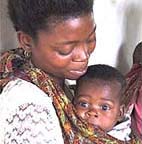|
||||

|
|
|||||||
|
Financial Sustainability of Childhood Immunization: Dr. Ruth Levine, Dr. Magdalene Rosenmöller and Peyvand Khaleghian EXECUTIVE SUMMARY This paper, commissioned by the Financing Task Force of the Global Alliance for Vaccines and Immunization (GAVI), provides a framework for discussion of the financing of immunization in developing countries. Narrowly, the paper is intended to contribute to the development of a template for the preparation of the financial sustainability plans required of countries receiving grants under the Children’s Vaccine Fund. More broadly, the paper seeks to help leaders in poor and wealthier nations think about specific actions that can contribute to—or conflict with—a long-term goal of stable and adequate financing for childhood immunization. Childhood immunization represents one of the quintessential “best buys” for the health sector, yielding tremendous benefits for individuals and society. The intervention is most effective when coverage is at 80 percent or higher, and when children are immunized during a rather narrow age span. These characteristics imply that the greatest health benefits are reaped when immunization programs can depend on adequate levels of funding on a reliable basis. In developing and industrialized countries alike, the financing of immunization is primarily a domestic and public sector responsibility: a core public health function of the state. However, the political nature of resource allocation decisions, competition among health (and other) programs for very scarce resources, large increases in funding requirements as coverage expands and new vaccines become available all add up to the potential (and reality) that dependence on domestic government resources alone will leave poor countries falling further and further away from achieving the benefits of immunization. Out of both self-interest and a concern for social welfare in poor nations, the international community may see some level of financing of immunization services in developing countries as a global responsibility. This perspective has been manifested historically in grant support from wealthy countries to poor ones for the development of basic childhood immunization programs (primarily through the Expanded Program on Immunization). Currently, as significant coverage gaps for routine immunizations are found, and as new and more costly vaccines are added to immunization schedules, resource transfers for immunization programs continue under the Children’s Vaccine Fund and through GAVI partners. Over the foreseeable time horizon, then, for many countries of the world, the financing of immunization services will be a shared responsibility: national governments have the primary role; and development partners have a secondary but crucial role. Broadening the Concept of Financial Sustainability. Traditionally, financial sustainability has been taken to mean the ability of a country to mobilize sufficient domestic (public and private) resources to finance a given set of goods and services, such as primary health care or family planning services. Financial sustainability has been synonymous with “self-sufficiency,” and often applied to situations where external financiers (aid agencies) sought to induce developing country governments to mobilize domestic resources for activities that previously had been donor-funded. However, more than for many other health interventions, the nature of immunization and the international interest in the future success of immunization programs may require that the focus of financial sustainability be shifted toward the ability of a country to mobilize and allocate sufficient domestic and external resources on a reliable basis to achieve target levels of immunization performance. The emphasis turns away from single-minded attention to phasing-out external funding, and toward the question of how to structure the full financing package—and, importantly, how to use available resources efficiently—so that sufficient funding is available on a reliable basis. Specific actions can be taken by developing country governments and development partners to promote this objective. Dimensions of Financial Sustainability. Financial sustainability is part and parcel of good management of immunization programs, and of the health sector as a whole. Many of the facets of financial sustainability overlap with sound program management. We identify nine dimensions of financial sustainability of immunization systems, falling into the categories of efficiency in the supply chain, and appropriate funding structure. These are: Lower Costs through Efficiency in the Supply Chain
Reliable and Sufficient Revenues through Appropriate Funding Structure
Government Actions to Foster Sustainable Financing. Among the many actions that national governments can take to evolve toward higher and more stable levels of funding for immunization systems, the following stand out as the ones with the highest potential impact:
Development Partner Actions to Promote Sustainable Financing. As noted above, it is likely that external aid will continue to play an important role in financing immunization services in many developing countries, and development partners are motivated to provide funding in a way that is reliable and fosters high levels of immunization coverage. There are actions that donor (and lending) agencies can take within the constraints of existing funding instruments. There are certainly ways in which standard funding mechanisms can be made less detrimental to the cause of financial sustainability. Key messages from an assessment of the advantages and disadvantages of different instruments are:
Indicators of Financial Sustainability. Indicators of financial sustainability should be selected based on the criteria of: validity and reliability; availability of data (without special collection procedures); relevance to worker and ease of explanation; relevance in variety of country contexts; and relationship to high priority policies and programmatic actions. Applying these criteria, the Financing Task Force may select among a large number of indicators of financial sustainability. Section VI of the paper lists these possible indicators. It is recommended that in establishing uniform indicators and setting targets toward financial sustainability, GAVI:
1 This paper was prepared by Ruth Levine (World Bank), Magdalene Rosenmöller (World Bank) and Peyvand Khaleghian (Consultant). Comments should be directed to: Ruth Levine (rlevine1@worldbank.org) and Violaine Mitchell (vmitchell@pacificcoast.net). This paper is intended to promote discussion of issues, and does not represent the views of the World Bank.
|
|||||||
|
|
|||||||
